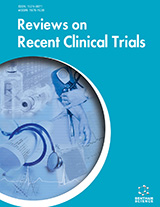Abstract
Bronchiectasis is defined by the presence of abnormal bronchial widening and occurs as a consequence of chronic airway infection. It is an important and common cause of respiratory disease. Antibiotics are the main therapy used for the treatment of this condition. The article will review the use of antibiotics for the treatment of bronchiectasis. Antibiotics can be given as short-term therapy for exacerbations or as long-term/maintenance therapy. Antibiotics given by the inhalational route and macrolides are two relatively new classes of medication that may be useful for long-term therapy. There are significant concerns about the overuse resulting in antibiotic resistance. It should be emphasized that nearly all of the trials in the literature have only had small numbers of subjects. The data that is available describing the use of antibiotics in bronchiectasis can generally be regarded as preliminary.
Keywords: Bronchiectasis, Lung, Inhalational, Macrolide, Antibiotic Resistance, co-existent disease, cystic fibrosis, gentamicin, haemoptysis, debility
Reviews on Recent Clinical Trials
Title: Use of Antibiotics in Bronchiectasis
Volume: 7 Issue: 1
Author(s): Paul T. King and Peter W. Holmes
Affiliation:
Keywords: Bronchiectasis, Lung, Inhalational, Macrolide, Antibiotic Resistance, co-existent disease, cystic fibrosis, gentamicin, haemoptysis, debility
Abstract: Bronchiectasis is defined by the presence of abnormal bronchial widening and occurs as a consequence of chronic airway infection. It is an important and common cause of respiratory disease. Antibiotics are the main therapy used for the treatment of this condition. The article will review the use of antibiotics for the treatment of bronchiectasis. Antibiotics can be given as short-term therapy for exacerbations or as long-term/maintenance therapy. Antibiotics given by the inhalational route and macrolides are two relatively new classes of medication that may be useful for long-term therapy. There are significant concerns about the overuse resulting in antibiotic resistance. It should be emphasized that nearly all of the trials in the literature have only had small numbers of subjects. The data that is available describing the use of antibiotics in bronchiectasis can generally be regarded as preliminary.
Export Options
About this article
Cite this article as:
T. King Paul and W. Holmes Peter, Use of Antibiotics in Bronchiectasis, Reviews on Recent Clinical Trials 2012; 7 (1) . https://dx.doi.org/10.2174/157488712799363280
| DOI https://dx.doi.org/10.2174/157488712799363280 |
Print ISSN 1574-8871 |
| Publisher Name Bentham Science Publisher |
Online ISSN 1876-1038 |
 39
39
- Author Guidelines
- Bentham Author Support Services (BASS)
- Graphical Abstracts
- Fabricating and Stating False Information
- Research Misconduct
- Post Publication Discussions and Corrections
- Publishing Ethics and Rectitude
- Increase Visibility of Your Article
- Archiving Policies
- Peer Review Workflow
- Order Your Article Before Print
- Promote Your Article
- Manuscript Transfer Facility
- Editorial Policies
- Allegations from Whistleblowers
Related Articles
-
L-DOPA Suppressed Scratching Behavior and Modified Brain Monoamine/ Amino Acid Concentrations in Mice
Letters in Drug Design & Discovery Pd/C-mediated Synthesis of 3-methyleneisoindolin-1-ones: Biological and Theoretical Study of their PDE4 Inhibition
Letters in Drug Design & Discovery Quinone-Based Drugs: An Important Class of Molecules in Medicinal Chemistry
Medicinal Chemistry Development and Potential Utility of Dual and Triple NK Receptor Antagonists
Current Topics in Medicinal Chemistry The Toxicology of Chemokine Inhibition
Mini-Reviews in Medicinal Chemistry Appraisal of Anti-Arthritic and Anti-Inflammatory Potential of Folkloric Medicinal Plant <i>Peganum harmala</i>
Endocrine, Metabolic & Immune Disorders - Drug Targets Interleukin-25: Key Regulator of Inflammatory and Autoimmune Diseases
Current Pharmaceutical Design The Patents on Glucocorticosteroids and Selected New Therapies for the Management of Asthma in Children: Update
Recent Patents on Inflammation & Allergy Drug Discovery L-Type Calcium Channels
Current Pharmaceutical Design Triterpene Derivatives as Inhibitors of Protein Involved in the Inflammatory Process: Molecules Interfering with Phospholipase A2, Cycloxygenase, and Lipoxygenase
Current Drug Targets Phosphodiesterase: An Interface Connecting Cognitive Deficits to Neuropsychiatric and Neurodegenerative Diseases
Current Pharmaceutical Design Chemical Profile and Anticancer Activity of Polyscias guilfoylei Leaf Essential Oil
The Natural Products Journal Synthesis of Gold Mediated Biocompatible Nanocomposite of Lactone Enriched Fraction from Sahadevi (Vernonia cinerea Lees): An Assessment of Antimalarial Potential
Current Topics in Medicinal Chemistry Hemopoietic Cells with Features of the Mast Cell and Basophil Lineages and their Potential Role in Allergy
Current Drug Targets - Inflammation & Allergy Biopharmaceutical Potential of Two Ramalina Lichens and their Metabolites
Current Pharmaceutical Biotechnology Neuroimmune Interactions and Psychologycal Stress Induced by Cohabitation with a Sick Partner: A Review
Current Pharmaceutical Design Editorial [Hot Topic: New Insight in Obesity and Insulin Resistance (Guest Editor: Geltrude Mingrone)]
Immunology, Endocrine & Metabolic Agents in Medicinal Chemistry (Discontinued) Kidney Diseases and Chemokines
Current Drug Targets Editorial [Hot Topic: Drugs and Pregnancy (Guest Editor: Zaneta Kimber-Trojnar)]
Current Pharmaceutical Biotechnology Use of Toll-Like Receptor 3 Agonists Against Respiratory Viral Infections
Anti-Inflammatory & Anti-Allergy Agents in Medicinal Chemistry


























